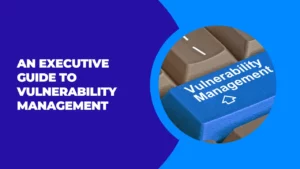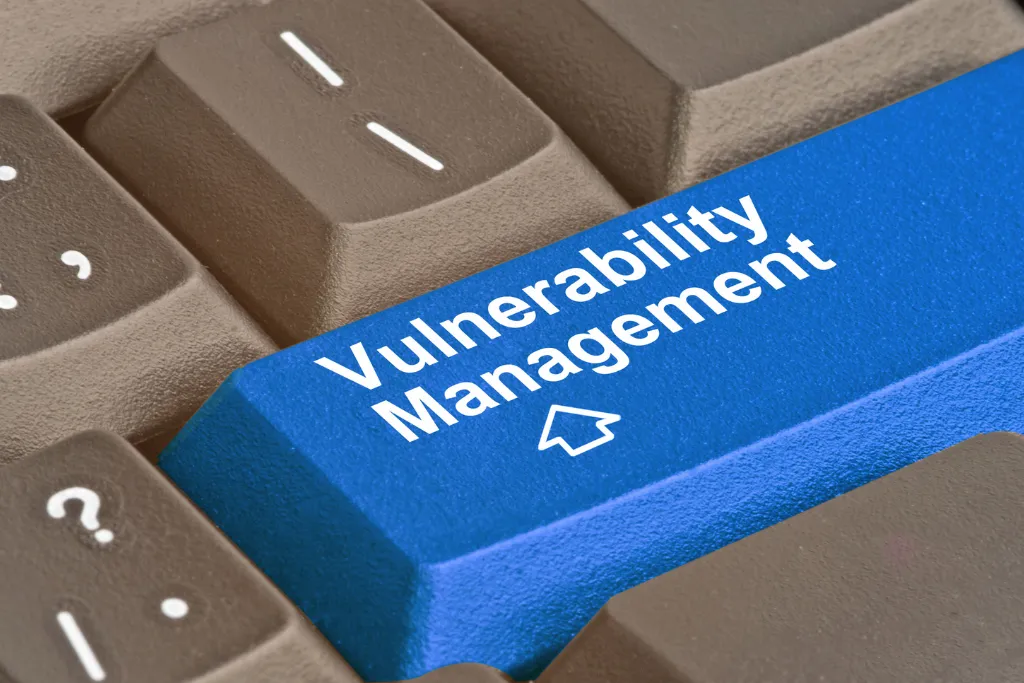Physical Address
304 North Cardinal St.
Dorchester Center, MA 02124
Physical Address
304 North Cardinal St.
Dorchester Center, MA 02124

In the world of cybersecurity, there’s no such thing as too much protection. With the rise of sophisticated cyberattacks, businesses need to be on their toes when it comes to vulnerability management.
But what exactly is vulnerability management, and why is it essential in 2024? In this executive guide, we will dive deep into the essence of vulnerability management, its importance in today’s digital world, and how it improves network security.
We will also explore the challenges that come with vulnerability management and their solutions. Additionally, we will discuss the features of a robust vulnerability management system and its benefits for businesses.
As we move towards 2024 and beyond, we will also touch upon emerging trends in vulnerability management and whether all businesses are ready to face these challenges head-on.

Organizations rely on vulnerability management to identify and address security vulnerabilities. Conducting vulnerability assessments allows them to prioritize remediation efforts based on severity. Regularly scanning for vulnerabilities helps proactively protect sensitive data.
Vulnerability management solutions provide real-time visibility into network and endpoint security. By staying ahead of attackers, organizations can minimize the risk of breaches. Effective vulnerability management is crucial in today’s digital landscape.
Vulnerability management, an essential process in any organization, involves continuously assessing, prioritizing, and remediating vulnerabilities in its systems. By using vulnerability scanners to detect weaknesses and evaluate their criticality, organizations can reduce the risk of exploitation and potential security breaches.
Implementing vulnerability management programs enables businesses to establish security controls, track remediation efforts, and measure the effectiveness of their security measures.
The essence of vulnerability management lies in proactively identifying and addressing vulnerabilities, ensuring the security of business operations.
As the threat landscape continues to evolve in 2024, organizations face new vulnerabilities and attack vectors on a regular basis. In order to maintain a strong security posture, vulnerability management becomes crucial.
With the increasing reliance on digital technologies and interconnected systems, the risks from cyber threats are higher than ever before. Vulnerability management provides a systematic approach to address vulnerabilities and protect against potential attacks.
By implementing effective vulnerability management practices, organizations can minimize the impact of security incidents and safeguard their assets.
The vulnerability management process encompasses various phases, including vulnerability scanning, prioritization, remediation, and validation. It relies on vulnerability scanners to identify vulnerabilities through network scans and analysis.
Prioritization is essential to focus remediation efforts on critical vulnerabilities with the highest risk. Remediation involves addressing vulnerabilities through patching, configuration changes, or other mitigation measures.
Validation ensures the effectiveness of the remediation efforts in resolving identified vulnerabilities.
The vulnerability management lifecycle encompasses several key phases. It starts with asset discovery, where all devices and systems within the organization’s network are identified.
Next is vulnerability scanning, which involves using vulnerability scanners to detect vulnerabilities in the identified assets. Prioritization then comes into play, determining the order in which vulnerabilities should be addressed based on their severity and potential impact.
Remediation follows, entailing necessary actions to mitigate or eliminate vulnerabilities. Finally, validation verifies that the remediation efforts have successfully resolved the identified vulnerabilities.
Risk-based vulnerability management plays a crucial role in prioritizing vulnerabilities based on their potential impact on an organization’s assets and operations. By addressing high-risk vulnerabilities first, this approach helps allocate resources efficiently.
Taking into account factors such as the likelihood of exploitation and the potential consequences of a successful attack, risk-based vulnerability management enables informed decision-making.
This ensures that limited resources are allocated to vulnerabilities that pose the greatest threat, enhancing the overall effectiveness and efficiency of vulnerability management programs.
Read More: Everything You Need to Know About Penetration Testing in 2024

Vulnerability management encounters numerous hurdles that can impede its effectiveness. One major challenge is the overwhelming volume of vulnerabilities, causing difficulties in prioritization and resolution.
To enhance efficiency, automation, and machine learning can streamline vulnerability management processes. Timely patching of vulnerabilities, particularly in complex environments, presents another challenge that can be addressed through workflows and clear responsibilities.
Furthermore, a lack of visibility into assets and vulnerabilities necessitates comprehensive asset discovery and monitoring solutions to ensure effective vulnerability management.
Limited resources, including budget and personnel, can hinder the implementation and maintenance of an effective vulnerability management program. The dynamic nature of IT environments, with frequent changes and updates, makes it challenging to maintain an accurate inventory of assets.
The complexity of IT systems, such as diverse operating systems and applications, complicates vulnerability scanning and remediation efforts. Communication and collaboration between IT teams and other stakeholders can be a challenge, affecting the coordination of vulnerability management activities.
Gaining buy-in from senior management and ensuring organizational commitment to vulnerability management can also be an obstacle.
To effectively overcome challenges in vulnerability management, organizations can prioritize vulnerabilities based on potential impact and likelihood of exploitation.
Automation and vulnerability management tools streamline scanning, prioritization, and remediation processes. Clear workflows, assigned responsibilities, and regular reporting ensure timely patching and remediation. Regular training enhances IT teams’ knowledge and skills.
Engaging senior management promotes a culture of security awareness and organizational commitment. By implementing these strategies, organizations can navigate the complexities of managing vulnerabilities and strengthen their overall security posture.
Vulnerability management plays a crucial role in enhancing network security. By proactively identifying and addressing vulnerabilities, organizations can protect their network assets and sensitive data.
Regular scanning and remediation measures help detect and mitigate potential weaknesses, while real-time visibility enables proactive risk management. Ultimately, effective vulnerability management reduces the likelihood of successful attacks and minimizes potential damage.
Vulnerability Manager Plus plays a crucial role in bolstering security by identifying and resolving vulnerabilities. With its real-time scanning and remediation capabilities, the platform ensures timely mitigation of threats.
It prioritizes vulnerabilities based on severity and criticality, enabling organizations to focus on the most urgent issues. The comprehensive dashboards provide clear visibility into the network’s security posture, facilitating proactive risk management.
Moreover, Vulnerability Manager Plus streamlines vulnerability management workflows, maximizing efficiency in addressing potential risks.
A robust vulnerability management system should offer continuous monitoring, customizable reporting, automated remediation, integration with other security tools, and easy collaboration and communication.
It should constantly scan and monitor for vulnerabilities while allowing you to generate custom reports based on your needs. Automated remediation capabilities streamline the process of addressing vulnerabilities, and seamless integration with other security tools ensures comprehensive protection.
Collaboration features facilitate communication between departments, enhancing the overall effectiveness of vulnerability management.
In the ever-evolving threat landscape, vulnerability management plays a crucial role in strengthening network security. Having a dashboard for vulnerability management offers numerous benefits.
It provides increased visibility and easier tracking of progress in addressing vulnerabilities. Key features to look for in a vulnerability management dashboard include customizable views and real-time data updates.
Effectively utilizing such a dashboard involves setting measurable goals and regularly reviewing data. Many companies and organizations have successfully implemented vulnerability management dashboards to enhance their security measures.
Creating comprehensive vulnerability management reports is crucial in today’s technological landscape. These reports provide executives and stakeholders with actionable insights to effectively manage vulnerabilities.
Key components of a successful vulnerability management program include vulnerability scanning, patch management, and the use of automated tools to streamline the process and reduce the risk of human error.
To stay ahead of potential attacks, it’s important to stay up-to-date on the latest vulnerabilities and threat intelligence. By following best practices and leveraging these reports, organizations can better protect their assets from unauthorized access and mitigate IT risks.

Improved cybersecurity is a key benefit of vulnerability management as it helps identify and address vulnerabilities before they can be exploited by hackers. Compliance with regulations is another advantage, as many industries require vulnerability management to meet cybersecurity standards.
Businesses also enjoy cost savings by avoiding data breaches and other security incidents. Enhanced productivity is achieved when there are fewer security incidents to handle, allowing organizations to focus on their core operations.
Ultimately, vulnerability management provides executives and business owners with peace of mind knowing that their systems are secure and up-to-date.
Safeguarding against cyber threats is crucial in today’s digital landscape. An integrated approach to vulnerability management, including risk assessment and prioritization, enhances network security.
Utilizing automated tools and techniques for vulnerability scanning and detection further strengthens defenses. Effective patch management and remediation strategies are essential in addressing identified vulnerabilities.
Ongoing monitoring and continuous improvement of vulnerability management processes ensure optimal security. By implementing these best practices, organizations can proactively protect their networks from unauthorized access and mitigate IT risks.
In today’s digital landscape, vulnerability management plays a crucial role in improving compliance with industry standards and regulations. By identifying and addressing vulnerabilities promptly, businesses can reduce the risk of data breaches and unauthorized access.
Automated vulnerability management tools offer numerous benefits, including real-time scanning and treating software vulnerabilities. Effective vulnerability management strategies involve risk prioritization and continuous scanning to ensure that common vulnerabilities and exposures (CVEs) are addressed in a timely manner. By implementing these strategies, organizations can achieve improved compliance and reduced risks.
A strong vulnerability management program is comprehensive, covering all aspects of the organization’s IT infrastructure. Prioritizing vulnerabilities based on severity and potential impact is essential. It should have a clear process for identifying, assessing, and remediating vulnerabilities. Regular testing and audits ensure its effectiveness.
To ensure a successful vulnerability management program, there are key components that should be in place. Continuous vulnerability scanning is necessary for identifying potential security vulnerabilities.
Prioritization and risk assessment help determine which vulnerabilities require immediate attention. Patch management ensures timely application of software updates. Vulnerability remediation involves addressing identified vulnerabilities through fixes or workarounds.
Employee training and awareness play a crucial role in educating employees about security best practices. Monitoring and reporting are essential for tracking the program’s effectiveness and providing regular updates to senior leadership.
Companies of all sizes can benefit from implementing a vulnerability management program. This program helps identify and address potential security threats, ensuring that sensitive information is protected.
IT professionals responsible for network security also benefit from the program, as it provides them with the tools and resources to effectively manage vulnerabilities. Ultimately, customers and stakeholders benefit from knowing that their data is being safeguarded by a company that prioritizes security.
Vulnerability assessment is the process of identifying vulnerabilities in your systems, while vulnerability management goes beyond identification and includes remediation. Both processes are crucial for maintaining a strong security posture.
Effective vulnerability assessment requires the use of vulnerability scanners, which scan servers, laptops, and user accounts for common vulnerabilities and exposures (CVEs) listed in the National Vulnerability Database (NVD).
The vulnerability management process prioritizes and remediates vulnerabilities in real time, treating them as baseline IT risks to prevent unauthorized access and potential malware attacks.
Vulnerability assessment scans your network to identify and evaluate security flaws, including misconfigurations and open ports. By using the Common Vulnerability Scoring System (CVSS), it provides real-time visibility into the severity of vulnerabilities.
Regular vulnerability assessments are essential for effective risk management, ensuring that potential security risks are identified and addressed promptly. This proactive approach helps protect against unauthorized access, malware attacks, and other software vulnerabilities.
With its ability to assess vulnerabilities on-premises and across servers, laptops, and user accounts, vulnerability assessment is a critical component of any comprehensive vulnerability management program.
Vulnerability management platforms play a crucial role in complementing vulnerability assessment. They track and prioritize vulnerabilities, allowing organizations to evaluate their criticality effectively.
These platforms also provide dashboards and reports, simplifying the monitoring process. By combining vulnerability assessment with vulnerability management, organizations can remediate vulnerabilities efficiently and strengthen their security posture.
This holistic approach ensures that all vulnerabilities are treated promptly, minimizing the risk of unauthorized access and protecting sensitive data.
Machine learning will revolutionize vulnerability management by enhancing its capabilities. Encryption technologies will be crucial in securing sensitive data, and protecting it from hackers.
The integration of vulnerability management tools with SIEM solutions will provide comprehensive security monitoring. AI-driven automation will streamline the remediation process, making it faster and more efficient.
Furthermore, the focus will shift towards proactive identification of new vulnerabilities, allowing businesses to stay one step ahead of potential threats.
With these advancements, vulnerability management in 2024 and beyond will be more effective in protecting against cybersecurity risks.
In the fast-evolving landscape of cybersecurity, emerging trends in vulnerability management are shaping the way organizations protect their networks. Network security is becoming more comprehensive, covering all endpoints, from servers to laptops.
Vulnerability management programs are now leveraging real-time data to identify and remediate vulnerabilities promptly. Automation plays a crucial role in handling routine vulnerability scanning and remediation processes, freeing up resources for more strategic tasks.
Moreover, vulnerability management platforms provide actionable metrics, enabling organizations to prioritize and address vulnerabilities effectively. Collaboration between security teams and IT teams is also being enhanced to ensure a holistic approach to vulnerability management.
Is your business prepared to tackle the challenges of vulnerability management in 2024? Many organizations still struggle with basic practices and lack visibility into vulnerabilities, hindering effective mitigation.
Small businesses may face resource constraints, but training and education on vulnerability management are crucial for all. Outsourcing can be an option for some.
In conclusion, vulnerability management is crucial in today’s rapidly evolving cybersecurity landscape. With the increasing number of cyber threats and the growing complexity of IT infrastructures, organizations need to prioritize vulnerability management to protect their networks and data.
By understanding the essence of vulnerability management, implementing a robust vulnerability management program, and leveraging advanced tools like Vulnerability Manager Plus, businesses can improve their network security, achieve compliance, and reduce risks.
However, it is important to overcome common challenges and ensure that all stakeholders benefit from the vulnerability management program.
As we look ahead to 2024 and beyond, emerging trends in vulnerability management will continue to shape the future of cybersecurity. It is essential for businesses to stay prepared and adapt to these evolving challenges to maintain a strong security posture.